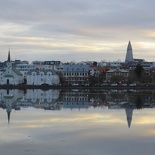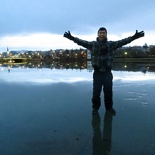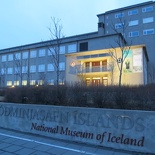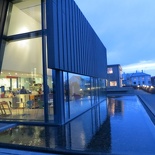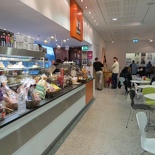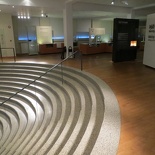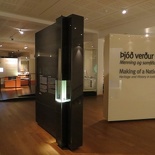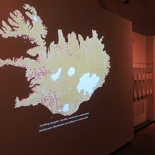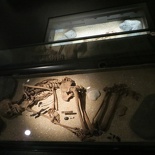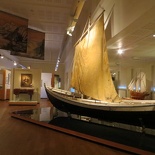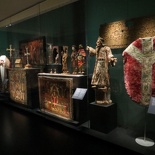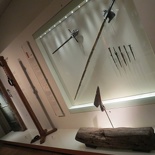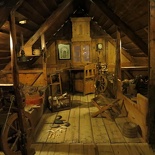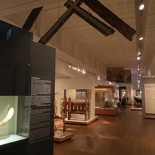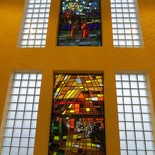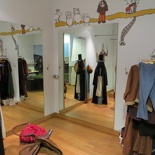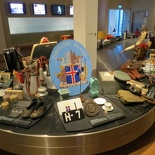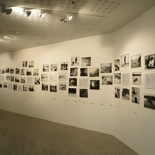Icelanders has plenty to be proud of their nomadic Viking history and the National museum of Iceland aims to showcase that. Established in 1863, the museum is located in the heart of Reykjavik on the northwest part of the city. The National Museum of Iceland is the country’s premiere historical museum showcasing the life and culture of its people from the early beginning to today through historical artifacts. It is very accessible via foot just across the lake Reykjavikurtjorn. It is centrally located within the city of Reykjavik itself and is very accessible by bus or walking.
Walking there allows you to enjoy much of the winter beauty otherwise missed on public transport. The lake Reykjavikurtjorn leading up to the museum is a place of beauty in the city, especially in the early morning right after sunrise. It is especially so in winter where it is frozen and reflective, offering really tranquil mirror views of the buildings of the other end of the lake.
On reaching the museum, the building is new, modern and was renovated in 2004 after extensive refurbishment. It has all the amenities you expect from museum- permanent and temporary galleries, as well as a museum dining café. The museum exterior has a combination of old and modern elements. You can make up the old parts of the museum building looking like part of an academic building built in older-style concrete with small windows, while the new wings of the museum has open large modern glass planes, especially those flaunting the front entrance of the museum complete ground-floor outdoor water pond elements.
A large semi-circular staircase greets you at the entrance of the museum galleries, where the museum lobby and ticketing counters reside too. Entry to the museum is a payable 2000 ISK, with half price discounts for students and seniors. You can obtain an audio guide which runs through the exhibits in sequence or at your choosing, get it to speak out a commentary of the exhibits of interest via keying in the exhibit number of interest.
The highlight of the Museum will be the “The Making of a Nation” permanent exhibition. The exhibition takes up most of the museum floor area, focused on showcasing the Icelandic heritage to visitors via artifacts and providing visitor insight into the history and formation of Iceland through stories told of the early life and static displays.
Early settlement days of Iceland
The galleries follow on chronologically, starting with the time periods from 800 to 1000 AD. This period saw the dawn of Icelandic society from the Vikings, who landed as nomads looking for a permanent settlement area to live from Norway. 1000 to 1200 saw the reign of the Christian revolution and chieftains, sort of a “tribal community” phrase. This is evident through the use of early tools dug from archeological finds.
Under the Norwegian rule and trade
The museum galleries provide insight into the history of the Icelandic nation from a nomadic settlement, under the rule of multiple rulers, to the present day. Iceland has a rather eccentric “happy go lucky” history of being taken under the rule of multiple different kings from different origins in their course as a young nation. For instance, the island came under the Norwegian rule from 1200 – 1400 AD with the Icelandic people pledging allegiance to the king of Norway.
This led to the extensive development of fisheries, transforming the local seafood industry, and providing for as the country’s principal export commodity. This is as shown by the number of fishing hardware, tools and even an entire large fishing boat on display. Despite Iceland now having an Army, there were early weapons on display used in the early days.
One of the main ancient items of display will include the Valþjófsstaður door, a church door in the Romanesque style dating from about 1200 AD. The exhibits follows into displays of Arts and Crafts, Social Culture and Language, depicted by paintings and scriptures showcasing the Icelandic language, which when spoken is a rather expressive and harsh sounding language.
The permanent exhibit houses several preserved Icelandic treasures, representing the cultural heritage in a historical context. Going chronologically, Iceland from 1400 to 1600 AD then came under the Danish rule, this came into effect when the king of Denmark came to rule over Norway and thus became king of Iceland, forcing the Icelandic church to become Lutheran.
Panorama of the National Museum of Iceland gallery
The galleries follows a systematic thematic route, first covering the locals Work and Way of Life, Homes and Settlement Patterns through live mock ups of actual wooden homes and scenes of daily life of the early Icelandic times. The attention to detail is even down even to the type of clothing worn by the inhabitants of the time.
Given Iceland moderately cold climate and harsh winters, there is evidently much investment in the use of warm clothing, as well as insulated homes. Some of the recreated early wooden houses on display in the museum galleries were complete detailed down to the tools and cutlery inside, painting a scene as authentic as what it was in the old Icelandic winter days. There are a number of interactive elements as well as informative boards beside each exhibits which you can dig more info on using the provided audio guides.
Modern Iceland
The galleries proceed on into the development of modern Iceland, such as the social-economic aspects of the country and way of life of the modern Icelandic people, such as government policies, education as well as the justification of not having a military. Iceland’s early economy started with relatively small population, with the economy thriving largely on agriculture from locally grown vegetables from the very fertile volcanic soil, as well as open water fishing, providing much of Iceland’s basic food consumption.
Agriculture provided much for Iceland needs through exports now, which is now overtaken by the booming Tourism industry given the sudden influx of tourists (and settlers from all over the world) to the little island. Given the number of volcanic features on the island, Iceland is largely energy independent with country set to be one of the global forefront leaders and geothermal energy too.
Other exhibitions
There were a number of temporary exhibitions running on my visit to the museum. This includes photo exhibitions as well as one dedicated on the people of Borata, photos laid out in clean contemporary photo galleries showcasing the works accumulated by the photographers from 2004-2012, capturing the reactions of the Icelandic people during the economic crisis and the country’s bankruptcy in 2012.
The National Museum has a variety of audio and visual elements, as well as small pigeon hole rooms with for kids with children toys, which will be of delight to children, especially in trying out various puzzles and games. The museum focus on historical artifacts of Iceland supplements the content displayed at the Saga Museum (with a focus more on people using figurines). You will be good in the National Museum of Iceland for at least half a day, with time to spare to explore the rest of the beautiful city of Reykjavik at your time.
View more photos of National Museum of Iceland in Reykjavik here.

